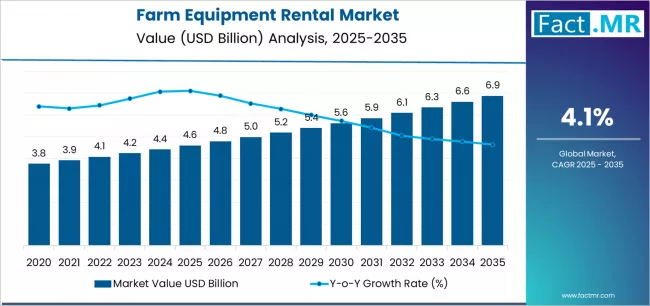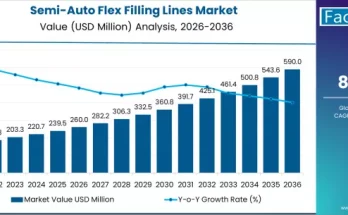Agricultural transformation is taking center stage as global food demand continues to rise. Mechanization has long been a driving force in improving productivity and efficiency, yet the high cost of advanced machinery often limits access for small and mid-sized farmers. This challenge has fueled the growth of the farm equipment rental market, offering a cost-effective and flexible solution for modern farming.
Farm equipment rental services enable farmers to access advanced machinery — such as tractors, harvesters, plows, and seeders — without the financial strain of ownership. This model promotes inclusive agricultural growth, boosts operational efficiency, and supports sustainability by maximizing equipment utilization.
Market Overview
The farm equipment rental market represents a crucial evolution in global agriculture, bridging the gap between technology and affordability. Traditionally, farm machinery was seen as an investment suited only for large-scale operations. However, with rising land fragmentation and cost pressures, renting has emerged as a practical alternative for smallholder farmers.
Rental platforms — both traditional and digital — allow farmers to access machinery based on seasonal demand or specific crop cycles. This pay-per-use approach helps minimize capital expenditure while ensuring access to modern equipment that can enhance crop yield and reduce manual labor dependency.
Furthermore, growing awareness about sustainable farming and precision agriculture has increased the demand for technologically advanced machines equipped with GPS guidance, automated controls, and efficient fuel systems. Rental providers are now investing in such equipment to cater to evolving agricultural needs, creating a dynamic ecosystem that benefits both service providers and farmers.
Regional Insights
North America remains a mature market for farm equipment rental, driven by the widespread adoption of advanced mechanization and the presence of organized rental service networks. The region’s focus on precision agriculture, automation, and digital booking platforms has streamlined rental operations for both large and small farms.
In Europe, sustainability and eco-friendly agricultural practices are influencing the rental landscape. Farmers increasingly prefer renting machinery that meets emission standards and supports soil-friendly cultivation. The European Union’s emphasis on sustainable rural development has further accelerated rental adoption among mid-sized agricultural enterprises.
The Asia-Pacific region is witnessing robust growth in farm equipment rentals, supported by government programs promoting rural mechanization and farm productivity. Countries such as India, China, and Indonesia are leading the charge with initiatives encouraging shared farming assets and equipment co-operatives. The rise of agritech startups offering app-based rental platforms is making equipment access easier and more transparent.
Meanwhile, Latin America, the Middle East, and Africa are gradually expanding their farm equipment rental markets as agriculture remains a key economic driver. These regions are focusing on improving mechanization rates and supporting smallholder farmers through public-private partnerships and micro-leasing programs.
Key Trends & Forecast
- Digitalization of Farm Equipment Rentals
The integration of online booking platforms and mobile applications is simplifying the rental process. Farmers can now compare prices, check equipment availability, and schedule machinery on-demand with just a few clicks. - Adoption of Precision and Smart Farming Tools
Modern rentals increasingly include GPS-enabled tractors, automated seeders, and drones. This shift reflects the industry’s move toward data-driven farming and efficient land management. - Sustainability and Resource Optimization
Renting farm machinery aligns with circular economy principles, allowing better utilization of existing assets while minimizing carbon emissions and fuel consumption. - Government Incentives and Subsidies
Many countries are introducing policies to promote equipment rental programs as part of agricultural modernization efforts. Subsidized rental centers and farm cooperatives are helping small farmers mechanize operations affordably. - Rising Popularity of Shared Ownership Models
In rural areas, community-based rental cooperatives are gaining traction, enabling farmers to share machinery and maintenance costs, thus improving access to high-quality equipment.
Applications & End-Use Outlook
Farm equipment rental services cover a wide spectrum of machinery and applications across the agricultural value chain.
- Land Preparation: Tractors, tillers, and plows are commonly rented for soil preparation and leveling before sowing.
- Planting and Seeding: Precision seeders and planters are rented to ensure uniform planting and optimize seed utilization.
- Crop Management: Sprayers, irrigation systems, and weeding equipment are rented to support mid-season crop maintenance.
- Harvesting: Combine harvesters and threshers are in high demand during harvest season, allowing multiple farmers to use them efficiently.
- Post-Harvest Operations: Equipment for packaging, sorting, and grain processing is increasingly available through rental platforms.
By offering access to specialized machinery throughout the agricultural cycle, the rental market helps farmers enhance productivity while minimizing operational expenses.
Competitive Landscape
The farm equipment rental market is characterized by a mix of regional players, agricultural cooperatives, and digital startups offering on-demand rental solutions. Established rental companies focus on expanding their fleets with technologically advanced and fuel-efficient machines, while startups are leveraging mobile technology to enhance accessibility and transparency.
Key players emphasize customer service, flexible rental durations, and maintenance support to build trust and loyalty among farmers. Some rental firms collaborate directly with manufacturers to ensure equipment reliability, performance tracking, and after-rental servicing.
Strategic partnerships between agritech firms, local cooperatives, and government agencies are also reshaping the competitive environment, ensuring rural accessibility and promoting inclusive mechanization.
Sustainability and Technological Advancements
The transition toward sustainable agriculture is driving innovation in the farm equipment rental market. Rental providers are integrating electric and hybrid machinery into their fleets to reduce emissions and fuel dependency. The emergence of smart farming technologies, such as AI-driven equipment monitoring and remote diagnostics, is further enhancing efficiency and minimizing downtime.
Additionally, data analytics and IoT integration enable rental companies to monitor usage patterns, predict maintenance needs, and optimize equipment allocation. This not only improves operational efficiency but also supports the long-term sustainability of agricultural resources.
Conclusion
The farm equipment rental market is redefining how farmers approach mechanization, offering a viable and inclusive alternative to equipment ownership. By bridging affordability gaps, promoting sustainability, and introducing digital solutions, rental services are becoming an essential pillar of modern agriculture.
As global food production continues to expand, access to reliable and advanced farm machinery will be critical for meeting growing demand. The rental model offers the flexibility and innovation needed to empower farmers across all scales — ensuring that agricultural progress remains both sustainable and economically inclusive.
In the years ahead, collaboration between technology providers, rental companies, and policymakers will continue to shape the evolution of the farm equipment rental market, making it a cornerstone of next-generation farming systems.
Browse Full Report – https://www.factmr.com/report/farm-equipment-rental-market



